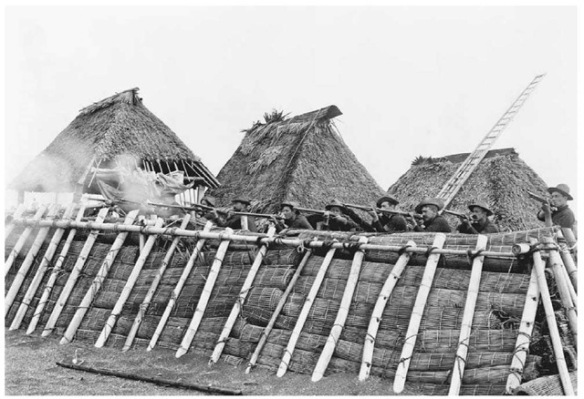American Soldiers in the Philippines, 1899. American soldiers fire their rifles from behind a makeshift barricade at the West Beach Outpost in San Roque during the Philippine insurrection that followed the 1898 Spanish-American War.
The United States exercised formal colonial rule over the Philippines, its largest overseas colony, between 1899 and 1946. American economic and strategic interests in Asia and the Pacific were increasing in the late 1890s in the wake of an industrial depression and in the face of global, interimperial competition. Spanish colonialism was simultaneously being weakened by revolts in Cuba and the Philippines, its largest remaining colonies.
The Philippine Revolution of 1896 to 1897 destabilized Spanish colonialism but failed to remove Spanish colonial rule. The leaders of the revolution were exiled to Hong Kong. When the United States invaded Cuba and Puerto Rico in 1898 to shore up its hegemony in the Caribbean, the U.S. Pacific Squadron was sent to the Philippines to advance U.S. power in the region, and it easily defeated the Spanish navy. Filipino revolutionaries hoped the United States would recognize and assist it. Although American commanders and diplomats helped return revolutionary leader Emilio Aguinaldo (1869– 1964) to the Philippine Islands, they sought to use him and they avoided recognition of the independent Philippine Republic that Aguinaldo declared in June 1898.
In August 1898 U.S. forces occupied Manila and denied the Republic’s troops entry into the city. That fall, Spain and the United States negotiated the Philippines’ status at Paris without Filipino consultation. The U.S. Senate and the American public debated the Treaty of Paris, which granted the United States ‘‘sovereignty’’ over the Philippine Islands for $20 million. The discussion emphasized the economic costs and benefits of imperialism to the United States and the political and racial repercussions of colonial conquest.
When U.S. troops fired on Philippine troops in February 1899, the Philippine-American War erupted. The U.S. Senate narrowly passed the Treaty of Paris, and the U.S. military enforced its provisions over the next three years through a bloody, racialized war of aggression. Following ten months of failed conventional combat, Philippine troops adopted guerrilla tactics, which American forces ultimately defeated only through the devastation of civilian property, the ‘‘reconcentration’’ of rural populations, and the torture and killing of prisoners, combined with a policy of ‘‘attraction’’ aimed at Filipino elites. While Filipino revolutionaries sought freedom and independent nationhood, a U.S.-based ‘‘antiimperialist’’ movement challenged the invasion as immoral in both ends and means.
Carried out in the name of promoting ‘‘self-government’’ over an indefinite but calibrated timetable, U.S. colonial rule in the Philippines was characterized politically by authoritarian bureaucracy and one-party statebuilding with the collaboration of Filipino elites at its core. The colonial state was inaugurated with a Sedition Act that banned expressions in support of Philippine independence, a Banditry Act that criminalized ongoing resistance, and a Reconcentration Act that authorized the mass relocation of rural populations.
In the interests of ‘‘pacification,’’ American civilian proconsuls in the Philippine Commission, initially led by William Howard Taft (1857–1930), sponsored the Federalista Party under influential Manila-based elites. The party developed into a functioning patronage network and political monopoly in support of ‘‘Americanization’’ and, initially, U.S. statehood for the Philippines. When the suppression of independence politics ended in 1905, it gave rise to new political voices and organizations that consolidated by 1907 into the Nationalista Party, whose members were younger than those of the Federalista Party and rooted in the provinces. When the Federalista Party alienated its American patrons and its statehood platform failed to win mass support, U.S. proconsuls abandoned it for the Nationalista Party, which over the remainder of the colonial period developed into a vast, second partystate, under the leadership of Manuel Quezon (1878– 1944) and Sergio Osmeňa (1878–1961).
Following provincial and municipal elections, ‘‘national’’ elections were held in 1907 for a Philippine Assembly to serve under the commission as the lower house of a legislature. The 3 percent of the country’s population that was given the right to vote swept the Nationalistas to power. The Nationalistas clashed with U.S. proconsuls over jurisdiction and policy priorities, although both sides also manipulated and advertised these conflicts to secure their respective constituencies, masking what were in fact functioning colonial collaborations. Democratic Party dominance in the United States between 1912 and 1920 facilitated the consolidation of the Nationalista party-state in the Philippines.
When Woodrow Wilson (1856–1924), a Democrat, was elected president in 1912, he appointed as governor-general Francis Burton Harrison (1873–1957), who, working closely with the Nationalistas, accelerated the ‘‘Filipinization’’ of the bureaucracy and allowed the Philippine Assembly to assume additional executive power. When Democrats passed the Jones Act in 1916, which replaced the commission with a Philippine senate and committed the United States to ‘‘eventual independence’’ for the Philippines, Quezon claimed credit for these victories and, despite his own ambivalence about Philippine independence, translated them into greater power. During the 1920s, Quezon dominated the Nationalista Party, using clashes with Republican governor-general Leonard Wood (1860–1927) to secure his independista credentials.
Under pressure from protectionists, nativists, and military officials fearful of Japanese imperialism, the U.S. Congress passed the Tydings-McDuffie Act in 1934. The act inaugurated a ten-year ‘‘Philippine Commonwealth’’ government transitional to ‘‘independence.’’ While serving as president of the commonwealth in the years prior to the 1941 Japanese invasion of the Philippine Islands, Quezon consolidated dictatorial power. Colonial political structures, constructed where the ambitions and fears of the Filipino elite connected with the American imperial need for collaborators, had successfully preserved the power of provincial, landed elites, while institutionalizing this power in a countrywide ‘‘nationalist’’ politics.
